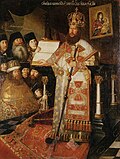Patriarch of Moscow and all Rus'
First Patriarchial Period (1589–1721)
| Patriarch | Worldly name | Period | Portrait | |
|---|---|---|---|---|
| St. Job | Ivan | 23 January 1589 | June 1605 |  |
| Ignatius [f] | 30 June 1605 | May 1606 | ||
| St. Hermogenes | Yermolay | 3 June 1606 | 17 February 1612 |  |
| Philaret | Fyodor Nikitich Romanov | 24 June 1619 | 1 October 1633 |  |
| Joasaphus I | 6 February 1634 | 28 November 1640 |  | |
| Joseph | Dyakov | 27 May 1642 | 15 April 1652 |  |
| Nikon | Nikita Minin (Minov) | 25 July 1652 | 12 December 1666 |  |
| Joasaphus II | Novotorzhets (nickname) | 10 February 1667 | 17 February 1672 |  |
| Pitirim | 7 July 1672 | 19 April 1673 |  | |
| Joachim | Ivan Petrovich Savelov | 26 June 1674 | 17 March 1690 | |
| Adrian [g] | Andrey | 24 August 1690 | 16 October 1700 |  |
Most Holy Synod (1721–1917)
The Ober-Procurator (Imperial Delegate having the procuration for religious affairs) was a non-clerical officer who assisted the Most Holy Synod from 1722 to 1917 after the Church reform of Peter the Great. The real "head" of the Synod and most important clerical figure was the Primus or Prime member, its legal chairman, always a Metropolitan or an Archbishop. The first Primus was the Metropolitan Stefan Yavorsky, who had been the administrator of the Patriarchate of Moscow for over twenty years (1700–1721).
After Paul I of Russia in 1797, the Emperor of Russia had the title of "Head of the Church".
Second Patriarchial Period (since 1917)
| Patriarch | Worldly name | Period | Portrait | |
|---|---|---|---|---|
| St. Tikhon | Vasily Ivanovich Bellavin | 4 (21) December 1917 | 7 April 1925 |  |
| Sergius | Ivan Nikolayevich Stragorodsky | 8 September 1943 | 15 May 1944 |  |
| Alexius I | Sergey Vladimirovich Simansky | 2 February 1945 | 17 April 1970 |  |
| Pimen | Sergey Mikhailovich Izvekov | 2 June 1971 | 3 May 1990 |  |
| Alexius II | Alexey Mikhailovich Ridiger | 10 June 1990 | 5 December 2008 |  |
| Kirill | Vladimir Mikhailovich Gundyaev | 1 February 2009 | Incumbent |  |